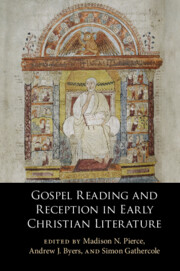Book contents
- Gospel Reading and Reception in Early Christian Literature
- Gospel Reading and Reception in Early Christian Literature
- Copyright page
- Dedication
- Contents
- Contributors
- Foreword: We Are All Gospel Readers
- Introduction
- Part I Reading the Gospel in Israel’s Scriptures
- Part II Gospel Writers as Gospel Readers
- 4 Why Not Matthew’s Use of Luke?
- 5 Luke Rewriting Matthew?
- 6 Reading Mark and Writing John
- 7 On Historical Epochê in Gospel Reading as Exemplified by John and the Egerton Papyrus
- Part III Gospel Reading as Ecclesial Tradition
- Bibliography
- Index of Ancient Sources
- Index of Modern Authors
- Index of Subjects
5 - Luke Rewriting Matthew?
The Case of the Sermon on the Plain
from Part II - Gospel Writers as Gospel Readers
Published online by Cambridge University Press: 27 January 2022
- Gospel Reading and Reception in Early Christian Literature
- Gospel Reading and Reception in Early Christian Literature
- Copyright page
- Dedication
- Contents
- Contributors
- Foreword: We Are All Gospel Readers
- Introduction
- Part I Reading the Gospel in Israel’s Scriptures
- Part II Gospel Writers as Gospel Readers
- 4 Why Not Matthew’s Use of Luke?
- 5 Luke Rewriting Matthew?
- 6 Reading Mark and Writing John
- 7 On Historical Epochê in Gospel Reading as Exemplified by John and the Egerton Papyrus
- Part III Gospel Reading as Ecclesial Tradition
- Bibliography
- Index of Ancient Sources
- Index of Modern Authors
- Index of Subjects
Summary
The literary relationship (if any) between Matthew and Luke continues to be debated, and so the relationship between the Sermon on the Mount and the Sermon on the Plain continues to be debated (with implications for how one reads both Matthew and Luke). This essay argues that the confluence of several facts – (1) obviously Matthean redaction is missing from Luke 6:21–49; (2) the more we subtract Matthean features from Matthew 5–7, the closer we get to the Sermon on the Plain; (3) 1 Clement 13:2, which seems to be independent of the synoptics, is closer at points to Luke 6:27–42 than it is to the Matthean parallels; (4) intertextual ties to Leviticus 19 are clustered in Luke 6:27–42 but separated in Matthew 5 and 7; and (5) in a number of instances, words and expressions in Luke 6:21–47 seem, by the standard tools of our trade, to be more original than their Matthean counterparts – adds up to a strong case that the Sermon on the Mount was not the source for the Sermon on the Plain. Luke is not a reader or an interpreter of Matthew’s Gospel. The data rather support the Q hypothesis or the theory that Matthew was a reader of Luke.
Keywords
- Type
- Chapter
- Information
- Gospel Reading and Reception in Early Christian Literature , pp. 94 - 121Publisher: Cambridge University PressPrint publication year: 2022
- 1
- Cited by



